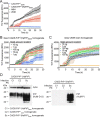Engineering a murine cell line for the stable propagation of hamster prions
- PMID: 30705093
- PMCID: PMC6442044
- DOI: 10.1074/jbc.RA118.007135
Engineering a murine cell line for the stable propagation of hamster prions
Abstract
Prions are infectious protein aggregates that cause several fatal neurodegenerative diseases. Prion research has been hindered by a lack of cellular paradigms for studying the replication of prions from different species. Although hamster prions have been widely used to study prion replication in animals and within in vitro amplification systems, they have proved challenging to propagate in cultured cells. Because the murine catecholaminergic cell line CAD5 is susceptible to a diverse range of mouse prion strains, we hypothesized that it might also be capable of propagating nonmouse prions. Here, using CRISPR/Cas9-mediated genome engineering, we demonstrate that CAD5 cells lacking endogenous mouse PrP expression (CAD5-PrP-/- cells) can be chronically infected with hamster prions following stable expression of hamster PrP. When exposed to the 263K, HY, or 139H hamster prion strains, these cells stably propagated high levels of protease-resistant PrP. Hamster prion replication required absence of mouse PrP, and hamster PrP inhibited the propagation of mouse prions. Cellular homogenates from 263K-infected cells exhibited prion seeding activity in the RT-QuIC assay and were infectious to naïve cells expressing hamster PrP. Interestingly, murine N2a neuroblastoma cells ablated for endogenous PrP expression were susceptible to mouse prions, but not hamster prions upon expression of cognate PrP, suggesting that CAD5 cells either possess cellular factors that enhance or lack factors that restrict the diversity of prion strains that can be propagated. We conclude that transfected CAD5-PrP-/- cells may be a useful tool for assessing the biology of prion strains and dissecting the mechanism of prion replication.
Keywords: CRISPR/Cas; Creutzfeldt-Jakob disease; bovine spongiform encephalopathy; cell culture; heterologous system; neurodegeneration; neuron; prion; protein aggregation.
© 2019 Bourkas et al.
Conflict of interest statement
The authors declare that they have no conflicts of interest with the contents of this article
Figures







Similar articles
-
Gene-edited murine cell lines for propagation of chronic wasting disease prions.Sci Rep. 2019 Aug 1;9(1):11151. doi: 10.1038/s41598-019-47629-z. Sci Rep. 2019. PMID: 31371793 Free PMC article.
-
The aminoglycoside G418 hinders de novo prion infection in cultured cells.J Biol Chem. 2021 Sep;297(3):101073. doi: 10.1016/j.jbc.2021.101073. Epub 2021 Aug 12. J Biol Chem. 2021. PMID: 34390689 Free PMC article.
-
A single protective polymorphism in the prion protein blocks cross-species prion replication in cultured cells.J Neurochem. 2023 Apr;165(2):230-245. doi: 10.1111/jnc.15739. Epub 2022 Dec 24. J Neurochem. 2023. PMID: 36511154 Free PMC article.
-
Prion encephalopathies of animals and humans.Dev Biol Stand. 1993;80:31-44. Dev Biol Stand. 1993. PMID: 8270114 Review.
-
Genetically engineered cellular models of prion propagation.Cell Tissue Res. 2023 Apr;392(1):63-80. doi: 10.1007/s00441-022-03630-z. Epub 2022 May 18. Cell Tissue Res. 2023. PMID: 35581386 Review.
Cited by
-
Astrocyte in prion disease: a double-edged sword.Neural Regen Res. 2022 Aug;17(8):1659-1665. doi: 10.4103/1673-5374.332202. Neural Regen Res. 2022. PMID: 35017412 Free PMC article. Review.
-
An astrocyte cell line that differentially propagates murine prions.J Biol Chem. 2020 Aug 14;295(33):11572-11583. doi: 10.1074/jbc.RA120.012596. Epub 2020 Jun 19. J Biol Chem. 2020. PMID: 32561641 Free PMC article.
-
Role of different recombinant PrP substrates in the diagnostic accuracy of the CSF RT-QuIC assay in Creutzfeldt-Jakob disease.Cell Tissue Res. 2023 Apr;392(1):301-306. doi: 10.1007/s00441-022-03715-9. Epub 2022 Dec 20. Cell Tissue Res. 2023. PMID: 36536226 Free PMC article. Review.
-
From Cell Culture to Organoids-Model Systems for Investigating Prion Strain Characteristics.Biomolecules. 2021 Jan 14;11(1):106. doi: 10.3390/biom11010106. Biomolecules. 2021. PMID: 33466947 Free PMC article. Review.
-
Asymmetric-flow field-flow fractionation of prions reveals a strain-specific continuum of quaternary structures with protease resistance developing at a hydrodynamic radius of 15 nm.PLoS Pathog. 2021 Jun 28;17(6):e1009703. doi: 10.1371/journal.ppat.1009703. eCollection 2021 Jun. PLoS Pathog. 2021. PMID: 34181702 Free PMC article.
References
Publication types
MeSH terms
Substances
LinkOut - more resources
Full Text Sources
Research Materials

